#Korean earthenware bowl bibimbap
Explore tagged Tumblr posts
Text
3COINS, Enjoy Korean cuisine just like the real thing! Earthenware pots/aluminum pots/seokyaki bibimbap pots/chijimi plates/stainless steel tableware, etc.
3COINS (3COINS) launched kitchen items to enjoy Korean cuisine at home. The lineup of cooking utensils is based on the image of a Korean diner with a homey, lively atmosphere, and allows for easy reproduction of such classic Korean dishes as hot stone-baked bibimbap, sundubu, pancakes, cold noodles, and kimbap, a sushi roll. Other items include a stainless steel rice bowl with lid, tableware for…
0 notes
Text
We were recently able to get our hands on the Ttukbaegi Pot with Lid 뚝배기 Korean Pot Ramen Pot Stone Clay Pots for Cooking Korean Pot Ceramic Cooking Pot Korean Stone Pot Korean Bowl Onggi Kimchi Pot (Large 30oz) Ttukbaegi Pot with Lid 뚝배기 Claypot and we were excited to give it a review! This pot is made with premium stoneware and has been glaze-fired twice with a natural glaze. It features traditional Korean colors and designs, making it a great choice for those looking to cook Korean delicacies or as a special gift for someone who loves cooking Korean food. The pot can also be used for bibimbap and can keep the food warm and make the rice crispy. Let's dive into this pot and see if it functions as well as it looks!Table of Contents1. Overview of the Ttukbaegi Pot2. Our Experience With the Ttukbaegi Pot3. Is The Ttukbaegi Pot Worth The Investment?Customer Reviews AnalysisPros & ConsFrequently Asked QuestionsUnleash Your True Potential1. Overview of the Ttukbaegi Pot We were excited to try out the Ttukbaegi Pot with Lid 뚝배기 Claypot. The pot is perfect for cooking delicious Korean dishes such as ramen, rice, soup, egg cusine and many more. The design of the pot is simple yet elegant, with Korean traditional colors and decorations. It also keeps the food warm for a longer period, which is a great bonus. The pot is made from premium stoneware (ceramics), fired twice with a natural glaze for extra durability. Not only is it perfect for cooking, but it also makes a great gift for anyone who loves Korean food, earthenware, or ttukbaegi. It comes in two sizes, 10oz and 30oz, so you can pick whatever size suits your needs. Surely, this pot is a must-have in any kitchen, not only for its beauty but also for its functionality.2. Our Experience With the Ttukbaegi Pot We have been using the Ttukbaegi Pot for about a month now, and we are incredibly satisfied with the results. It's made from a premium stoneware, glaze-fired twice with a natural glaze that visibly adds to the aesthetic of the product. It is also decorated with a traditional Korean design, featuring the classic red color. It has a wide range of uses from cooking ramen, rice and soups to making delicious Korean dishes like bibimbap and kimchi. Cooking with the Ttukbaegi Pot is a real treat. Our food has never tasted better, and the flavors are more intense and robust than before. We love the fact that it keeps our food warm and that the stoneware helps make the rice nice and crispy for bibimbap. While the pot itself is quite large, it's incredibly lightweight and easy to transport. We would highly recommend this product to anyone looking for the perfect clay pot for cooking Korean food. It is also an excellent gift, especially for enthusiastic cooks or those who love Korean culture and cuisine.3. Is The Ttukbaegi Pot Worth The Investment?When it comes to the question of whether or not the Ttukbaegi Pot is worth the investment, the answer is a resounding yes! The pot is exceptionally crafted using the highest quality fine clay and is glaze-fired twice with a natural glaze. The pot is also decorated with a traditional Korean color and design, making it great for bringing an authentic touch to your cooking. The pot is also incredibly versatile: it can be used for a variety of dishes, from bibimbap to ramen, rice, soup, and egg cuisine. What's more, the pot is specially designed to keep food warm and make rice crispy. Plus, it's a great gift for mothers, grandmothers, and chefs who love traditional Korean cuisine. With its fine craftsmanship and longevity, you can be sure it will last for years to come -- making it a worthwhile investment! Customer Reviews AnalysisCustomer Reviews Analysis We've gone through the reviews of the Ttukbaegi Pot With Lid 뚝배기 and are pleased to report that the consensus is overwhelmingly positive. Many customers, such as the one quoted above, have highlighted how great this pot is for cooking steamed eggs. They report that it is easy to clean and keeps the eggs nice and hot, making them a great way to start the day.
Other customers have noted that the stone clay construction of this pot makes it an excellent choice for long-term cooking. Whether they're crafting exquisite kimchi, brewing up a simple ramen, or any other tasty treat, this pot is capable of delivering consistently excellent results. Overall, we're confident that the Ttukbaegi Pot With Lid 뚝배기 is an investment worth making. If you're looking for a reliable pot for all your traditional Korean cooking needs, then this is it! Pros & ConsPros & Cons of Ttukbaegi Pot : Pros: The Ttukbaegi pot is the perfect vessel for preparing and cooking traditional Korean food such as ramen, rice, soup, egg cuisine, and more. Its design is enhanced with the traditional colors and design of Korean pottery, making it a perfect gift for mothers, grandmothers, aunts, and chefs who love authentic Korean pottery. It is made from a fine clay and glaze-fired twice with a natural glaze, making it durable and reliable. Widely used for bibimbap stone bowls, as it gives the rice an extra crispy texture and keeps the food warm for longer. Cons: The Ttukbaegi pot is liable to cracking if exposed to extreme temperatures, so be mindful of this while using it. To clean it properly, the pot should not be soaked in water for too long as it could lead to staining. It is heavy and may be difficult to lift if full. Frequently Asked QuestionsQ&A Q: What is the Ttukbaegi Pot With Lid 뚝배기? A: The Ttukbaegi Pot With Lid 뚝배기 is a Korean Pot made of premium stoneware (ceramics) and glaze-fired twice with a natural glaze. It is perfect for cooking Korean cuisine such as ramen, rice, soup, egg cusine, and bibimbap. Q: Does the pot come with a cover? A: Yes, it does! The pot comes with a lid decorated with Korean traditional color and design, which makes it great for keeping food warm and crispy. Q: Is it a good gift for someone? A: Yes! The Ttukbaegi Pot With Lid 뚝배기 makes a great gift for the Korean food-loving mother, grandmother, ant, or chef in your life. Unleash Your True PotentialWe hope you enjoyed our review of the Korean pot: Ttukbaegi Pot With Lid 뚝배기. If you're interested in trying it out for yourself, you can find it here: https://amazon.com/dp/B09QZJQCS2. Let us know in the comments how you like it!
0 notes
Text
youtube
Bibimbap
비빔밥
Rice mixed with vegetables, meat, an egg, and chili pepper paste
Today’s recipe is bibimbap, a super-popular Korean dish you might have heard about already! It’s made of a bowl of rice, sautéed and seasoned vegetables (namul: 나물), a bit of hot pepper paste (gochujang: 고추장), and usually a bit of seasoned raw beef, too (yukhoe: 육회).
Bibim (비빔) translates as “mixed,” and bap (밥) means “cooked rice,” so bibimbap literally means “mixed rice.” Before eating it you’re supposed to mix everything all together.
There are many variations on this dish, from simple to elaborate, and this recipe I’m showing you today is for one you could consider “classic” bibimbap. If you ordered bibimbap in a Korean restaurant, you would probably get something like this dish, with regional variations. I’m also going to show you bibimbap prepared and served in a heated stone or earthenware bowl called dolsot-bibimbap (돌솥비빔밥). “Dolsot” means “stone pot” in Korean, and this version is well-known for the way the bowl makes a layer of crispy, crackling rice on the bottom of the bibimbap.
Even though we mix up bibimbap before we eat it, each ingredient needs to be prepared with care and individuality, bringing out their unique flavors, textures and colors so they come together beautifully in the bowl and deliciously in your mouth. The different ingredients aren’t random, they’re chosen because they balance, harmonize, and offset each other.
This recipe isn’t quick and easy, it takes some time to make. But if you’re really in a rush you can make a great bibimbap with the soybean sprouts, spinach, and carrot (or red bell pepper, or both), and gochujang, toasted sesame oil, and an egg— those items are unskippable!
I’m going to share some more bibimbap recipes on my website in the future, and you’ll see how many different variations there are. This version is a little different than the version in my cookbook, because I make a quick and simple soup with the bean sprouts. When I started my YouTube channel, bibimbap was one of the first recipes I made, because it’s such an essential dish in Korean cuisine. So I’m happy to remake the video now in HD with much better editing and instruction. I’ve been building up to this video by remaking videos for the ingredients, too. I remade yukhoe, and sigeumchi-namul, and my yukagaejang video has a lot of detail about preparing the mountain vegetable fernbrake.
So if you’ve been following my videos, you’re now ready to be a bibimbap master! Ready? Let’s start!
Ingredients (serves 4)
5 cups cooked short-grain rice
12 ounces soy bean sprouts, washed and drained
8 ounces of spinach blanched and washed with the excess water squeezed out by hand
1 large carrot
1 large red bell pepper
1 large zucchini
1 English cucumber
3 to 4 green onions, chopped
½ pound fresh lean cut of beef (fillet mignon, flank steak)
4 ounces fernbrake (gosari), fresh or soaked from ½ ounce dried gosari (details below)
1 ounce dried bellflower roots (doraji), soaked in cold water for 18 to 24 hours.
4 eggs
kosher salt
vegetable oil
toasted sesame oil
toasted sesame seeds
garlic
soy sauce
honey (or sugar)
Korean hot pepper paste (gochujang)
How to prepare dried fernbrake (gosari) for use
If you have presoaked or fresh fernbrake you can use it straight away, but if you have dried fernbrake you’ll need to get it ready to eat. It’s fast if you have a pressure cooker, but if you don’t it will take some time.
With a pressure cooker:
Wash ½ ounce of dried gosari and boil it with 5 cups of water in a pressure cooker for 30 minutes.
Drain and rinse in cold water a couple of times.
Drain. It should make 4 ounces.
In a pot on the stove:
In a large saucepan add ½ ounce of dried gosari to 7 cups of water. Bring to a boil over medium-high heat and boil for 30 minutes. Cover and let stand until cool, about 2 to 3 hours.
Rinse the fernbrake a couple of times, drain and put in a bowl. Cover with fresh cold water and let soak for at least 8 hours or overnight in a cool place, changing the water 2 or 3 times during the soaking.
Taste the gosari: It should be soft. If it’s tough, boil it again in a fresh pot of water for about 20 minutes and then let it sit, covered, until soft.
Drain. It should make 4 ounces.
Make rice
If you have a usual method for making rice or have a rice cooker, go ahead and make 5 cups of rice like you usually do. But here’s how I do it on a pot on the stove. 2 cups of dried rice makes about 5 cups of cooked rice.
Rinse 2 cups of rice in cold water and scrub the wet rice with your hand. Rinse and drain until the drained water is pretty clear.
Put the rice in a heavy-bottomed pot. Add 2 cups of water, cover, and soak for 30 minutes.
Cook over medium high heat for 7 to 8 minutes until the surface is covered with abundant bubbles that are spluttering noisily and look like they’re about to overflow the pot. Turn the rice over a few times with a spoon and cover the pot again.
Turn the heat to very low and simmer for another 10 minutes until the rice is fully cooked and fluffy. Remove from the heat.
Fluff the rice with a spoon to release excess steam. Let the rice stand, covered, at room temperature to keep it warm.
Prepare and cook the ingredients for bibimbap
I like to get a big platter and then put each vegetable on it as they’re ready. I think it looks really pretty, but you don’t have to do this. When all vegetables are prepared and ready to use, the platter looks pretty delicious!
Soybean sprouts:
Put the soy bean sprouts in a pot and add 4 cups water and 2 or 3 teaspoons salt. Cover and cook for 20 minutes over medium high heat. Take out the sprouts with tongs and put them into a bowl, leaving about ½ cup of sprouts in the pot with the water you used to boil them. This is the soup to serve with bibimbap later.
In a bowl, mix the sprouts by hand with ½ teaspoons salt, 1 teaspoon minced garlic, and 2 teaspoons toasted sesame oil. Put them on the large platter.
Spinach:
Cut up the blanched spinach a few times and put it in a bowl. Mix by hand with 1 teaspoon garlic, 1 teaspoon toasted sesame oil, ½ teaspoon kosher salt, and 1 teaspoon sesame seeds. Cover and put it next to the soy bean sprouts on the platter.
Other fresh vegetables:
Cut the carrot into matchsticks, put them in a bowl, and mix with a pinch of salt. Let stand for 5 to 10 minutes until sweating.
Cut the red bell pepper into halves, deseed, and slice into strips. Put them in a bowl.
Cut the zucchini into matchsticks and mix with ½ teaspoon kosher salt.
Cut the cucumber into halves lengthwise and slice thinly crosswise. Mix with ¼ teaspoon kosher salt.
Beef:
Cut the beef into matchsticks and put them in a bowl.
Mix with 1 tablespoon minced garlic, 1 tablespoon soy sauce, 1 tablespoon honey, 2 teaspoons toasted sesame oil, and 1 teaspoon sesame seeds with a spoon.
Cover and keep in the fridge until ready to use.
Mountain vegetables:
Cut the fernbrake (gosari) a few times into bite size pieces. Set aside.
Put the bellflower roots (doraji) in a large bowl. Add 1 or 2 tablespoons salt. Rub for a minute to wilt slightly and release some of the bitterness. Rinse them in cold water a couple of times and drain. If you find some roots are too thick, split them lengthwise. Set aside.
Let’s cook!
Heat up a pan over medium high heat. Squeeze out excess water from the carrot. Add a few drops of cooking oil to the pan and sauté the carrot for 1 minute. Put it on the platter next to the soy bean sprouts and spinach. Clean the pan with wet paper towel or wash it.
Heat a few drops of cooking oil in the pan and squeeze out the excess water from the cucumber. Sauté with ½ teaspoon minced garlic and a few drops of toasted sesame oil for 30 seconds. Put it on the platter. Clean the pan.
Heat up the pan with a few drops of cooking oil. Add the red bell pepper and sprinkle a pinch of salt over top. Sauté for 30 seconds. Put it on the platter. Clean the pan.
Heat up the pan and squeeze out excess water from the zucchini. Add a few drops of cooking oil and sauté with 1 teaspoon minced garlic, 1 tablespoon chopped green onion, a drop of toasted sesame oil for 1 minute until slightly softened. Put it on the platter. Clean the pan.
Heat up the pan with a few drops of cooking oil. Add the bellflower roots and sauté for 2 to 3 minutes. Lower the heat to medium so as not to brown them. Add 1 teaspoon minced garlic and a drop of toasted sesame oil. Stir for another minute until a little softened. Put it on the platter. Clean the pan.
Heat up the pan. Add a few drops of cooking oil. Stir the gosari for 2 minutes until a little softened. Add ½ teaspoon of minced garlic, 2 teaspoons soy sauce, and 2 teaspoons sugar, and keep stirring for another minute. Put it on the platter.
Serve
Here are a couple of ways to serve: bibimbap in a regular, shallow bowl, and dolsot-bibimbap in a stone or earthenware bowl.
In a regular, shallow bowl
Reheat the soybean sprout soup.
Divide the cooked rice into 4 portions. Each portion will be a little more than 1 cup of rice.
Put the rice in each of 4 bowls and arrange the vegetables and beef on the rice. Top with a raw egg yolk and gochujang. If you prefer your eggs and beef cooked, use a fried egg sunny side up and slightly pan-fry the beef before putting them on the top of rice.
Sprinkle the bibimbap with the sesame seeds and drizzle with sesame oil to taste.
Ladle the soup to a small bowl and sprinkle some chopped green onion over top.
Serve right away with more hot pepper paste on the side, and maybe kimchi too.
Dolsot-bibimbap in a hot earthenware bowl (ttukbaegi) or hot stone bowl (dolsot)
Reheat the soybean sprout soup.
Put a few drops of toasted sesame oil in the bottom of each of 4 earthenware bowls. They should be big enough to hold 4 to 6 cups each.
Divide the rice among the bowls. Arrange the vegetables and beef on the rice. Top each serving with a raw egg yolk and 1 tablespoon gochujang. If you prefer your eggs and beef cooked, use a fried egg sunny side up and slightly pan-fry the beef before putting them on the top of rice.
Set each pot on a burner. Heat over medium high heat until you hear a ticking, crackling sound coming from the rice.
Sprinkle the bibimbap with the sesame seeds, drizzle with sesame oil to taste.
Ladle the soup to a small bowl and sprinkle some chopped green onion over top.
Serve right away with more hot pepper paste on the side and maybe kimchi too.
Eat
Gently but firmly mix everything together in the bowl with your spoon. Try not to crush the more delicate ingredients.
Eat with your spoon.
Posted on Sunday, January 6th, 2008 at 11:14 pm. Last updated on September 18, 2022.
#bibimbap#bibimbap recipe#dolsot bibimbap#돌솥비빔밥#비빔밥#homemade bibimbap#hot stone bowl bibimbap#how to eat bibimbap#how to make bibimbap#how to make dolsot bibimbap#Korean earthenware bowl bibimbap#korean food#Korean Mixed Rice with Meat and Assorted vegetables#Korean mixed rice with vegetables and meat#Korean recipes#Korean stone pot bibimbap#rice mixed with vegetables#spicy mixed rice#stone bowl bibimbap#Youtube#kfood#korean#food#foodie#recipe#bts#rm#jin#suga#jhope
6 notes
·
View notes
Text
Korean Food in Abu Dhabi
It's nearly impossible to not fall in love with Korean food, which features meat that is grilled right on the table in front of you, steaming hot stews, chilies, and pickles.
I'm going to share 10 of the best-tasting dishes from Korean cuisine with you in this food guide.
Now is the time to eat delicious Korean food in Abu Dhabi.
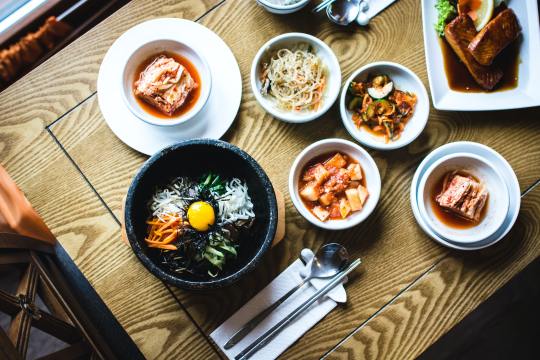
1. Kimchi I'm going to start this South Korean food list with something that isn't really a dish at all, but is crucial to any Korean meal: KIMCHI. While there are numerous varieties of kimchi, the most common is made from napa cabbage that has been preserved and lightly fermented in bright red chili flakes. You're on your way to becoming a Korean food connoisseur if you enjoy kimchi!
2. Samgyeopsal A South Korean foodie favorite is fatty slices of pork belly grilled right in front of your nose. With a few slabs of this incredibly tasty pork and garnishes of lettuce leaves, garlic, and chili paste, you've got a flavor to remember.
3. Bulgogi Pork Bulgogi is another well-known Korean barbecued meat specialty. While bulgogi is traditionally made with beef, it can also be made with thin strips of pork or chicken. Before grilling, the meat is marinated in sweet soy sauce, garlic, and sesame oil. The version I ate above came from Dwaeji Bulgogi, a New Valley restaurant in Seoul that specializes in pork bulgogi.
4. Stew for a Hangover When I first arrived in South Korea, I was eager to try the famous Korean hangover stew. It arrived in a steaming earthenware dish. Haejangguk comes in a variety of flavors, but the one I had was made with pork spine bones. The broth was rich and spicy, with tender chunks of fatty pork and Korean chili paste as flavors.
5. Stew with Soft Tofu Sundubu Jjigae is a flavorful Korean dish served in a flaming hot pot. There isn't much more comforting on a cold rainy day than this dish, which is made with super soft tofu, a few bits of seafood, addictive kimchi soup, and an egg thrown on top.
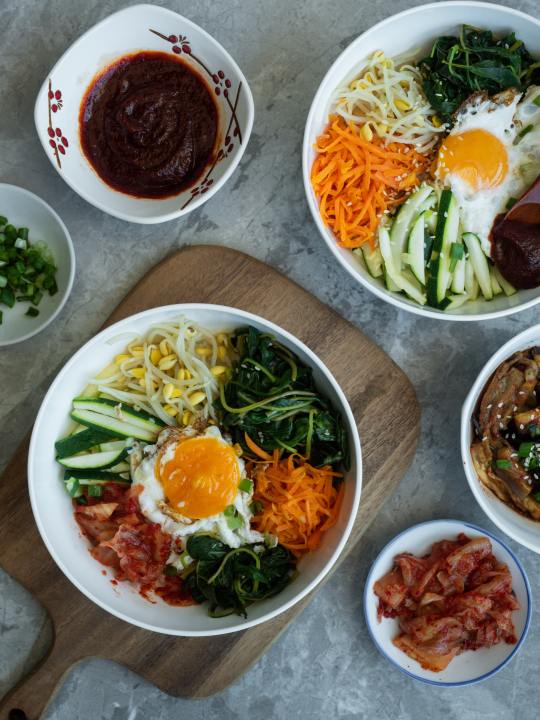
6.Soup with Korean Ox Bones The highlight of Korean seolleongtang is ox bones simmered on low heat for hours and hours. The dish is served with a few light noodles, beef slices, and green onions. The broth is delivered unsalted and unseasoned, so season with salt, pepper, chili paste, and extra green onions to taste.
7.Korean Mixed Rice The cold version, like the Dolsot Bibimbap mentioned above, is served in a metal pot. Bibimbap is a fantastic lunchtime delight when all of the ingredients are combined. I liked both the cold and hot versions, but if I had to choose, I'd go with the scorching hot dolsot bibimbap.
8.Japchae I've always loved stir-fried translucent noodles. The Korean version is delicious, with chewy stir-fried sweet potato noodles mixed with slivers of carrots, cucumber, onions, mushrooms, and occasionally meat pieces. Japchae has a mouthwatering fragrance and a flavor you'll love. It's fried in sesame oil and garnished with toasted sesame seeds.
9.Tteokbokki If you're looking for Korean street food, tteokbokki is probably the first thing you'll come across - it's all over Seoul! It's the poke bowl of Seoul, a popular, easy-to-eat, and delicious dish.
10.Gimbap The SPAM musubi was created in Hawaii using original Japanese ideas, and the gimbap was created by Koreans. Gimbap is one of South Korea's most popular foods, whether eaten as a meal or as an on-the-go snack. Gimbap is an assemblage of sushi rice, a few Korean pickled vegetables, spinach, and ham wrapped in sheets of toasted seaweed, similar to a Japanese style hand roll.
1 note
·
View note
Text
Seoul🧡
Welcome To The Foodaholics Hub!!!
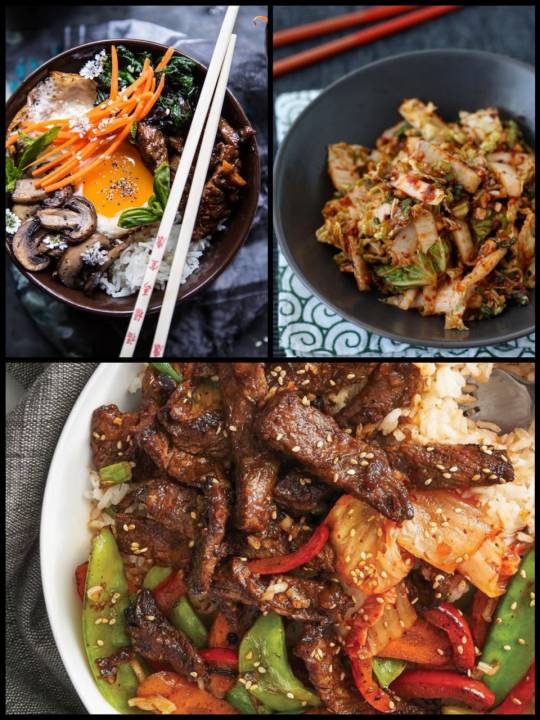
Like most of you people requested
So guyz
We're finally here with our second blog!!
The city we chose this time is Seoul!!!
We're gonna talk about the must try dishes of Seoul
And rest assured
You won't regret reading this blog because of the varieties this city has to offer!
Seoul is the paradise for foodaholics!!
If you do happen to visit Seoul, you can open your eyes to a world of tasty treats!!
There are so many dishes that are so unique and different from other asian cuisines.
So let's start!!!
.
.
.
.
#1 BIBIMBAP-

Bibimbap , sometimes Romanized as bi-bim-bap or bi-bim-bop, is a Korean rice dish. The term "bibim" means mixing various ingredients, while the "bap" noun refers to rice. Bibimbap is served as a bowl of warm white rice topped with namul (sautéed and seasoned vegetables) and gochujang (chili pepper paste), soy sauce, or doenjang (a fermented soybean paste). A raw or fried egg and sliced meat are common additions. The hot dish is stirred together thoroughly just before eating.
#2 KIMCHI-
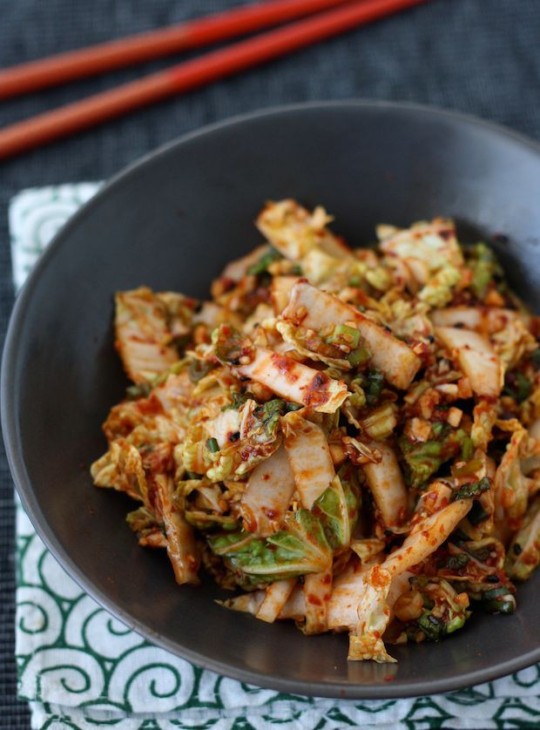
Kimchi , a staple in Korean cuisine, is a traditional side dish of salted and fermented vegetables, such as napa cabbage and Korean radish, made with a widely varying selection of seasonings including gochutgaru (chili powder), spring onions, garlic, ginger, and jeotgal (salted seafood), etc. It is also used in a variety of soups. There are hundreds of varieties of kimchi made with different vegetables as the main ingredients. Traditionally, kimchi was stored in-ground in large earthenware to prevent the kimchi from being frozen during the winter months. It was the primary way of storing vegetables throughout the seasons. In the summer the in-ground storage kept the kimchi cool enough to slow down the fermentation process.
#3 BULGOGI BEEF SLICES-
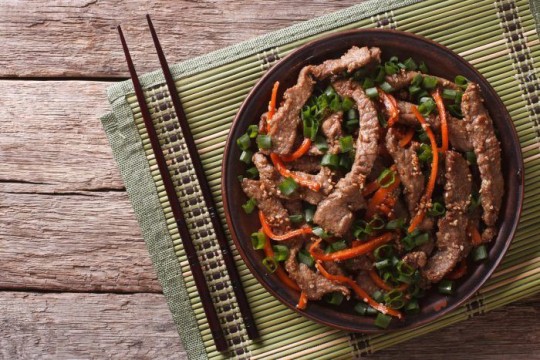
Bulgogi is a Korean-style grilled or roasted dish made of thin, marinated slices of beef or pork grilled on a barbecue or on a stove-top griddle. It is also often stir-fried in a pan in home cooking. Sirloin, rib eye or brisket are frequently used cuts of beef for the dish. Bulgogi is believed to have originated during the Goguryeo era (37 BCE–668 CE), when it was originally called maekjeok with the beef being grilled on a skewer. It was called neobiani meaning "thinly spread" meat, during the Joseon Dynasty and was traditionally prepared especially for the wealthy and the nobility. In the medieval Korean history book Donggooksesi , bulgogi is recorded under the name yeomjeok which means 'fire meat'. It was grilled barbecue-style on a hwaro grill on skewers, in pieces approximately 0.5 cm thick. Although it is no longer cooked skewered, this original type of bulgogi is today called bulgogi sanjeok .
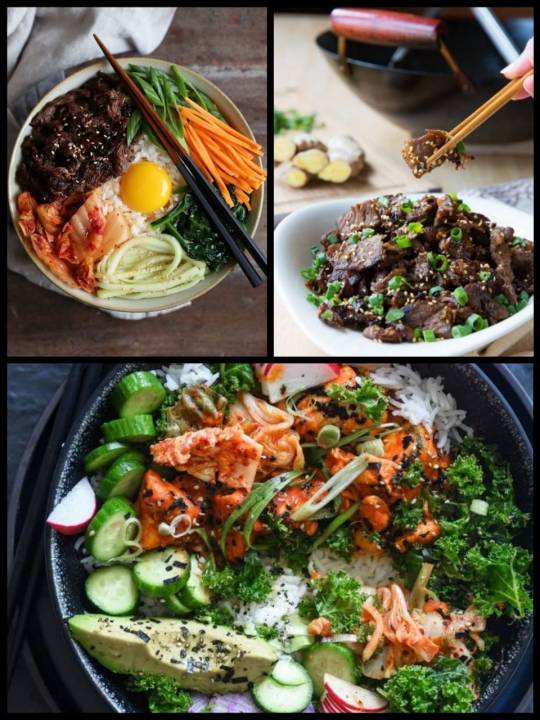
If you do like our blog
Make sure you do comment down your reviews or any other questions!!
We'll be happy to answer!!!
0 notes
Text
Critical Vegan Korean Food You Want To Try
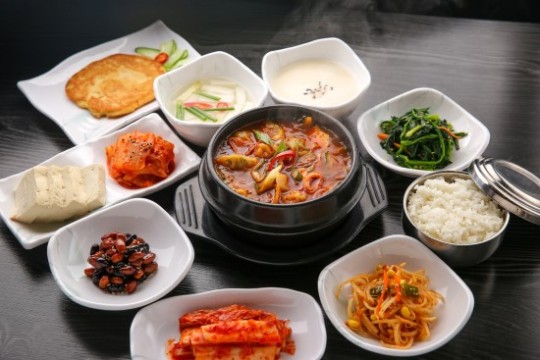
Need to understand your bibimbap? Our suggestion to antique dishes, sides, sauces, and tipples will make you familiar on this cuisine.
Bibimbap
If you've eaten any Korean dish, it really is almost certainly this: a bowl of rice topped with all tidy heaps of meat, sautéed vegetables, and also a sunny side up egg arranged like paint on an artist's palette. Bibimbap is served at a stone bowl that produces a crispy crust of rice combined the other borders. Yangpun bibimbap has been served.
Galbi
Korean fashion, barbecue. The version has been marinated short ribs grilled over wooden charcoal. Spin offs include a patty of minced beef rib which is as near since you are going to visit some Korean hamburger, tteokgalbi along with chicken and pork galbi. If you're generating galbi don't dash into the marinating--it is what makes the beef tenderize in it cooks and maintain flavor.
Bossam
This assemble-it-yourself dish suggests"wrapped" What you are going to blend in lettuce or sometimes in Napa cabbage, is sliced plus a bit of salted fish along with radish salad, pork abdomen.
Bindaetteok
To take it a pancake doesn't really do justice to it. For bindaetteok, earth mung beans have been pan fried with onions or sometimes peppers until crusty and nice. It really is so hot that it has made the jump from road food.
youtube
Hanjeongsik
An elaborate feast produced for Korean royalty, it stems filling the table together with heaps of dishes, instead of a person Western-style, at the same time. Much thought goes to a hanjeongsik dinner, also it is not easily duplicated in your property.
Banchan
A boggling smorgasbord of complimentary side dishes kimchi, seaweed salad, pickles, bean sprouts, cucumbers, braised potatoes, and much more exerts most Korean food. Eat up, as refills are free.
Kimchi
Korea's iconic sidedish of hot and sour fermented vegetables, kimchi is just a staple of popular Korean food. It is traditionally made from Napa cabbage and radishes, together with additives that include salted shrimp, ginger, fish sauce, garlic, and pepper aromas.
Gochujang
Even though hot condiment may look like ketchup, it's made from fermented soybeans rice, red chili, and salt. For its depth, gochujang can be utilized as a paste in marinades, or thinned with plain water for soups and sauces.
Doenjang
This fermented soybean glue is relied upon to include more thickness
Along with umami to dishes. It really is some thing similar to miso but on steroids. Certainly one of its applications is like a base a traditional Ink, for jjigae.
Makgeolli
While gobbling bindaetteok is a million times better when fresh, rather than heated and sealed to get a international journey, the white rice everyone drinks.
Soju
A highly effective, and ubiquitous booze, à la vodka, soju is distilled from barley, rice, wheat, or potatoes and served fine or in cocktails.
Hangover-Stew
Korean hangover treatment arrived in a piping earthenware dish. There really are a number of unique versions of Haejangguk. The broth was hot and rich, roasted with tender chunks or greasy pork and also chili paste that is Korean.
0 notes
Text
A foodie tour of South Korea
With the Winter Olympics shining a spotlight on this hi-tech country, a new culinary trip introduces visitors to zingy rice dishes and the worlds best bibimbap all with a pleasingly messy disregard for formality

A foodie tour of South Korea
South Korea holidays
A foodie tour of South Korea
With the Winter Olympics shining a spotlight on this hi-tech country, a new culinary trip introduces visitors to zingy rice dishes and the world’s best bibimbap – all with a pleasingly messy disregard for formality
Liz Boulter
Fri 9 Feb 2018 01.30 EST
Share on Facebook
Share on Twitter
Share via Email
View more sharing options
Share on LinkedIn
Share on Pinterest
Share on Google+
Share on WhatsApp
Share on Messenger
Close
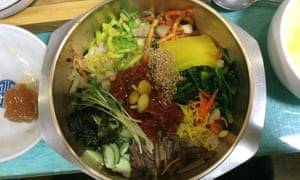
Korean comfort … bibimbap is the national dish of rice with a multitude of toppings.
I’m not particularly hungover, having stuck to local Hite beer the evening before, but the restorative effects of Korean haejang-guk, or “hangover soup” would probably cure even the pain of a truly big night out.
At 8am there’s already a queue outside the tiny cafe at the back of Nambu market in provincial capital Jeonju (has the whole city been on the lash?). I slip into a seat at the counter next to a local couple and watch an overalled woman bashing energetically at huge mounds of pungent garlic, chilli and spring onion – a cruel racket for a pounding head.
South Korea map
But soon my panacea appears: a heady beef bone and anchovy broth thick with rice and beansprouts, side dishes of kimchi and three other fermented vegetables, and squares of dried seaweed to dip in. Another dish holds a barely set poached egg. Copying my neighbours, I finish up by adding some broth to the egg, stir, and drink the lot down, following up with the (probably redundant) little plastic bottle of Yakult-type drink that comes with every serving.
The words “set you up for the day” don’t even begin to cover it.
Hangover soup counter, Jeonju. Photograph: Liz Boulter for the Guardian
Quick guide
South Korea: at a glance
Show Hide
– Capital: Seoul
– Currency: Won, £1=1,500
– Flight time from UK: 11 hours
– Flight time from US (Los Angeles): 13 hours 30 minutes
– Population: 51 million
– Area:100,210 km2
– Official language: Korean
– Official tourism website: visitkorea.or.kr
– High speed rail network: KTX
– Looking for more travel ideas? Guardian Travel on South Korea
Was this helpful?
Thank you for your feedback.
I’m two days into Intrepid Travel’s new Real Food Adventure in South Korea and starting to appreciate how this hi-tech country combines the best of east Asia, particularly in its cuisine: healthier and less oily than in much of China; spicier, sharper and chewier than in Japan.
Starting in the capital, Seoul, we’ve done the basics – Korean barbecue and moreish KFC (the K’s not for Kentucky) – then taken the train south (almost all the trip is on public transport) to foodie capital Jeonju, declared a Unesco city of gastronomy in 2012. Jeonju is known for its “slow food” skills: drying, pickling and fermenting kimchis, sauces and pastes to offer a world of exquisite textures and flavours. It’s only culinary rival was, before the Korean war, Pyongyang.
An irresistible dish of KFC (Korean fried chicken).
Jeonju is also home to the country’s best bibimbap, the national dish of rice with an array of toppings, often including a raw egg. As we’re lunching at the city’s Gajok Hoegwan restaurant, and its owner, Kim Nyeon-him, has been declared an intangible cultural asset by the government for her bibimbap, we’re probably going to eat the best bibimbap in the world.
“This is not your meal; these are just the accompaniments,” warns Daniel, our Korean-American tour leader. The tables are covered with at least a dozen cold side dishes: pungent fish innards, mild turmeric jelly and delicious fermented spring greens among them. Our bibimbaps arrive topped with a dozen more tasty things, plus a hot cloud of steamed egg soufflé. It looks very pretty, but we have to destroy it: the way to eat bibimbap is to add your side dishes, mix the whole lot up – with chopsticks so as not to mash the rice – then shovel it in with a spoon.
Mrs Kim is an “intangible cultural asset” thanks to her bibimbap. Photograph: Liz Boulter for the Guardian
The taste sensation is partly down to the array of tall earthenware jars where Mrs Kim, sprightly in her seventies, is fermenting sauces of gooseberry, green plum and other fruits. Daniel tells us bibimbap is comfort food: in Korean films the equivalent of the breakup scene where a girl eats a whole tub of ice-cream is a girl crying into a big bowl of bibimbap.
Korean food is all about side dishes, or banchan
By now our group of 12 Europeans and Australians are starting to “get” Korean food. It’s all about the side dishes, or banchan: no meal comes without at least two. For this we can thank the Buddhist vegetarian influence, which saw people brightening up meals with fresh, sour, crunchy, sweet, salty or spicy accompaniments. This continues even though many Koreans have since embraced meat and fish with gusto.
We’ve also rethought our western ideas about courses. Everything comes together: there’s nearly always a soup with a Korean dinner, but it’s sipped throughout the meal, and any sweet things are on the table from the start. Koreans say this makes an evening more fun: you get on with talking, laughing, enjoying the company, without interruptions for another course arriving. There’s also none of Japan’s dining formality. “The protocol is there is no protocol,” says Daniel. It’s fine to all dip spoons into one pot, or reach across your companions to grab a tasty morsel with your long metal chopsticks. A table barely visible under a mess of dirty dishes and empty bottles is the sign of a good night out.
Gochujang ferments in a jar for months. Photograph: Liz Boulter for the Guardian
The savoury spiciness of bibimbap comes from gochujang, the fermented chilli paste found in every Korean kitchen. The home of that is nearby Sunchang, where, with the help of another intangible cultural asset, Kang Soon-ok, we learn how “red gold” is made – by mixing powdered rice, barley syrup, soya and dried chillies before leaving it to ferment for half a year.
We also have great fun making a speciality none of us can quite get our heads round: chapssaltteok, or soft rice cakes (like Japanese mochi). Their sticky, gooey texture is achieved, traditionally, by pounding the rice flour dough with huge mallets, before rolling, chopping and sprinkling it with ground nuts. We’ve loved almost everything we’ve eaten so far, but decide you probably have to be born to it to rave about this texture, between Blu Tack and wallpaper paste, but less appealing than either.
Much more enticing is the quintessential Korean dish kimchi, which we also have a go at in Jeonju. There are kimchi factories these days of course, but many people still make it by hand in autumn, to ferment in jars buried in the cold ground for winter eating.
Hanok village, on the edge of Jeonju. Photograph: Seungchan Lee/Getty Images
In a sunny courtyard in the traditional Hanok village district, on the edge of Jeonju, the napa cabbages (what we call Chinese leaves) have been soaking in brine. Pulling on gloves and pinnies (against red stains) we copy our hosts and gently peel back the pale leaves – without detaching them from the stems – and massage each side with a paste made by pounding garlic, shallot and ginger with copious gochujang. Once every surface of every leaf is covered – inexpert tourist fingers are fumbling and slow – the leaves are folded back till the finished cabbages lie like so many swaddled babies. I taste a bit of broken leaf and it’s delicious, but without that deep fermented flavour of aged kimchi.
There are many more delights packed into the week. The waters of Bomun lake make an especially pillowy soft tofu, served at Matdol Soondooboo restaurant in a punchy broth. You drop in a raw egg, add soy, sesame oil and spring onions, then enjoy the way creamy egg and tofu contrast with the soup’s chilli kick. Spicy beef short ribs on Daegu’s foodie Dongindong Street have been steamed for hours and come with fishy side dishes for an umami hit.
The fish market in Busan. Photograph: Alamy
And in the port of Busan, we barbecue seafood at the table. The US influence means South Koreans have a very un-Asian liking for dairy products: so you can add grated cheese to a giant clam grilling in its shell with onion, chilli and kimchi and, as the cheese starts to melt, gorge on a fusion feast.
But it isn’t all eating; there’s drinking too. The craft beer movement is starting to take off in South Korea: at microbrewery Galmegi in Busan we taste IPAs and a ginger golden ale. They’re a hit with young South Koreans used to rice wine, fizzy lager and soju spirit. For us, though, Hite beer and soju make perfect partners for games of “sink the ship” – the person who makes the shot glass of soju sink into the lager having to drink the lot. And if too many rounds of that make for a sore head next morning, there’s always hangover soup.
• The trip was provided by Intrepid Travel, whose eight-day South Korean Real Food Adventure costs £1,715, excluding flights to Seoul
from All Of Beer http://allofbeer.com/a-foodie-tour-of-south-korea/
0 notes
Photo

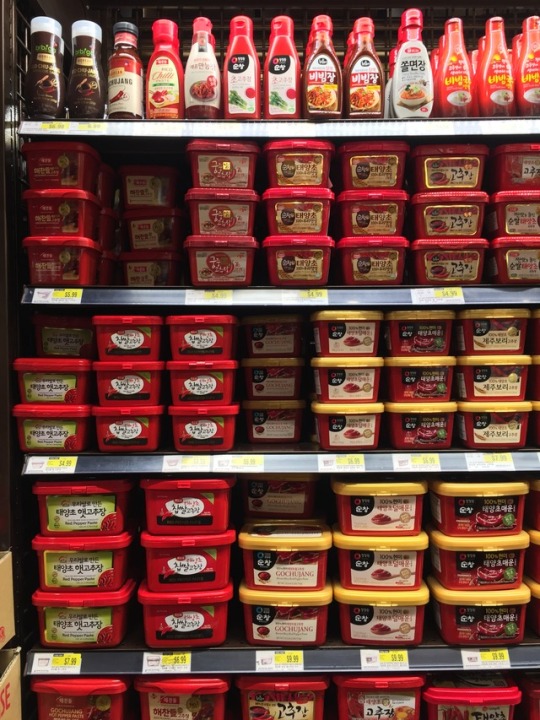

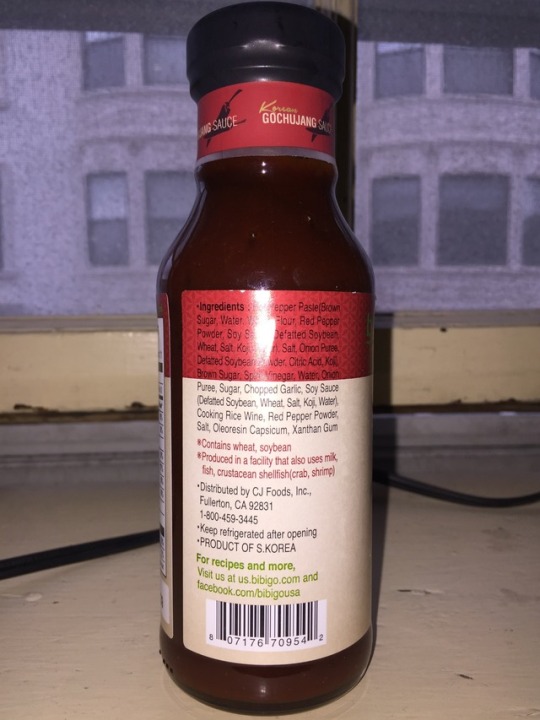
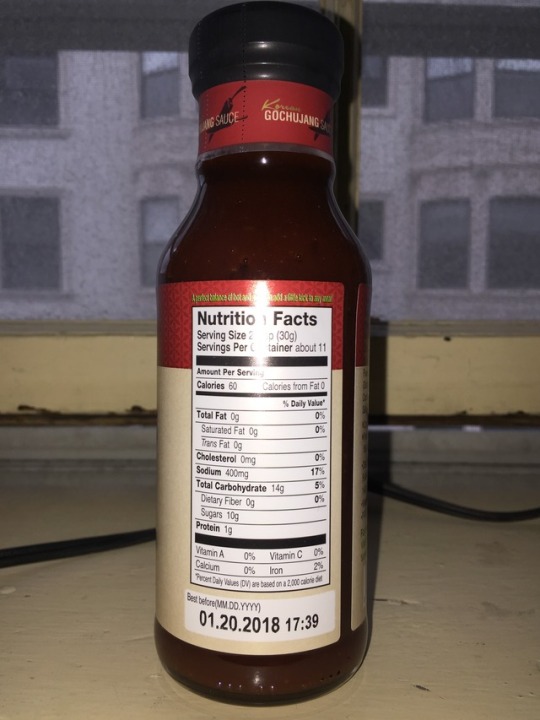
Kenny Chu
Gochujang is a staple Korean condiment made from red chiles, glutinous rice, meju (dried fermented soybeans), and salt. The ingredients, in powder form, are mixed with water, and sometimes sweeteners such as sugar or honey, to form a pungent, fermented, thick, dark red paste. The word gochujang, which means hot pepper paste, comes from gochu, the Korean chili pepper used in the paste, and jang, meaning sauce. The heat of gochujang can be adjusted; often, the packaging that the sauce comes in will indicate its spice level. Although it is a chili paste, gochujang serves a much more central role in Korean cuisine than other chili pastes do. Because it is both spicy and somewhat sweet, it is used not only as a seasoning in flavorings, marinades, and dipping sauces, but also as a key ingredient in soups and stews (jjigae), rice bowls (bibimbap), and rice cakes (ddeokbokki).
Gochujang has long been used in Korean cuisine, both for its versatility as an ingredient and for its nutritional values. Records dating back 1,500 to 2,000 years ago indicate that fermented foods, such as gochujang and kimchi, were already a part of Korean agricultural. In fact, in a document dating back to the late 1400s, both the agricultural period and season of gochu harvesting were recorded, indicating the importance of gochu cultivation in traditional Korean life. Further scientific evidence indicates that gochu is most likely a pepper native to the Korean peninsula, although it is part of the Capsicum annuum species. Unlike some other chili pastes however, gochujang can be made only with gochu, simply because using other spicy peppers such as Mexican or Thai chili peppers would made it too spicy to consume. In addition to this, gochujang was commonly eaten for its nutritional and health benefits. Historical records show that it was often eaten with braised chicken, green onion, and ginger to promote health. Other writings indicate how it helped people combat digestive problems or symptoms of a stroke. Its use in traditional Korean medicine helped to keep it at the forefront of Korean diets to this day.
Traditionally, gochujang was a homemade sauce, starting from gochu cultivation and harvest, to fermentation, preparation, and production. It was kept in onggi, or Korean earthenware, which had properties perfect for fermenting foods such as gochujang or kimchi, as well as storing and preserving such foods. These pots were gathered outside in an open space, specifically called jangdokdae, commonly found next to traditional Korean houses, even to this day. Modern-day gochujang production and consumption doesn't stray far off from the old process and purposes though. Many old traditions and concepts are still used, although substitute ingredients are sometimes used in place of the primary ones in some cases. However, as commercial production of food became more widespread with the advent of factories and canning, gochujang began showing up in the mass market, appearing in supermarkets and grocery stores all over the world. Its purpose in food though has since stayed the same: to enhance flavors and nutritive values in food.
Because of the importance of gochujang in Korean cuisine, it was the first thing I encountered walking down the condiments and sauces aisle. As seen in the second photo, there was a wide selection of different bottles and containers to choose from, all containing gochujang or a variety of it, sold in different sizes and spice levels from different companies. And despite the variety, upon first glance, it seemed as though all of the containers were the same because of their identical red color. The same apparent uniformity applied to the rest of the sauces down the aisle. Opening the bottle, I was greeted with a strong whiff of spicy, and upon tasting it, the peppery flavor came immediately, followed by hints of sweetness. It was a smell I always encountered whenever I ate at a Korean restaurant, accompanied by my bibimbap, or mixed into my sundubu-jjigae. Using the sauce was very easy, simply because it was already made; mixing it into a bowl of rice, bulgogi, vegetables, and a fried egg gave me a quick, very simple bibimbap. Although my Korean friends tell me that homemade gochujang sauce tastes better, I’m quite glad I don’t have to create it from scratch. Gochujang is a sauce I never avoid, despite needing a couple refills of cold water. Unlike sriracha or Tabasco, it never cuts through a dish's flavors, but rather brings the dish together and completes it. Indeed, its sweet spicyness makes it the perfect chili paste out there.
Sources:
Kwon, Dae Young; Jang, Dai-Ja; Yang, Hye Jeong; and Chung, Kyung Rhan. "History of Korean gochu, gochujang, and kimchi." Journal of Ethnic Foods, vol. 1, no. 1, 2014, pp. 3–7. http://dx.doi.org/10.1016/j.jef.2014.11.003.
Kwon, Dae Young; Chung, Kyung Rhan; Yang, Hye Jeong; and Jang, Dai-Ja. "Gochujang (Korean red pepper paste): A Korean ethnic sauce, its role and history." Journal of Ethnic Foods, vol. 2, no. 1, 2015, pp. 29–35. http://dx.doi.org/10.1016/j.jef.2015.02.006.
"The Wonders of the jangdokdae." Korea.net, 31 Oct. 2013, http://www.korea.net/NewsFocus/Column/view?articleId=114377.
0 notes